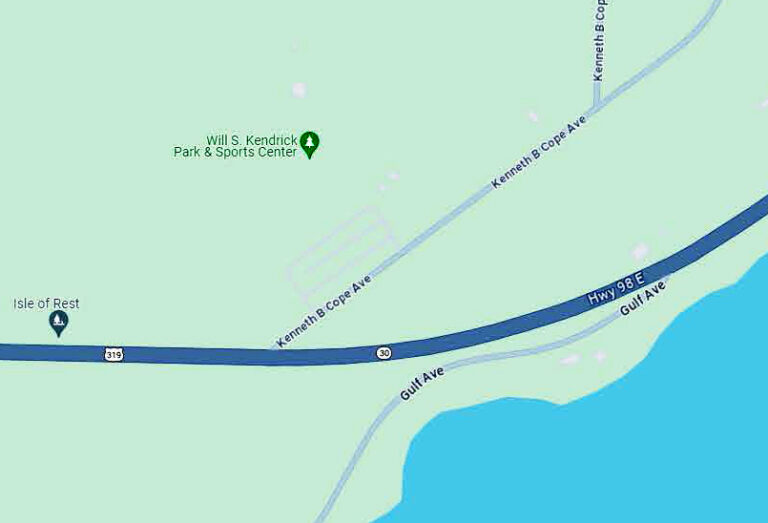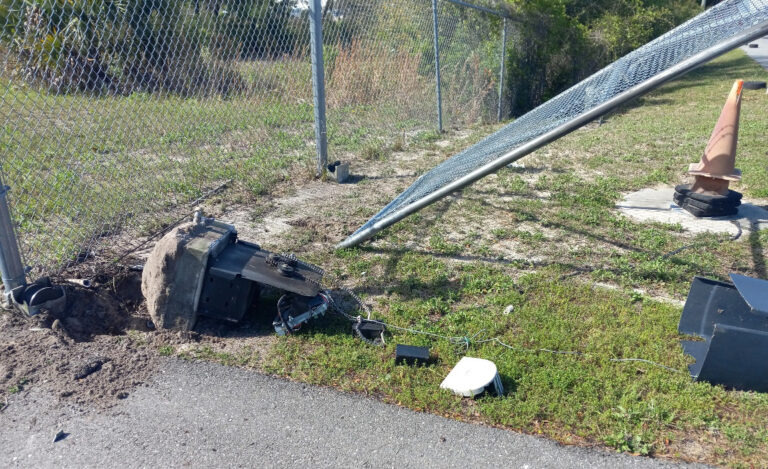Legacy Post Disclaimer
This is a #Legacy post imported from The Apalachicola Time’s previous platform. If you’re experiencing issues with this article, please email us at news@nevespublishing.com.
Remembering the passion of drive-ins
Just a mile-and-a-half from the house in Norfolk, Virginia, where I grew up was Wilder’s Drive-In Theater. The place had opened in 1948, when I was 3 years old, just as drive-ins were beginning to catch on. It had a huge screen, delish concessions, and spaces for 650 cars. My mom and dad, Maggie and Frenchie (so dubbed by his World War II Navy buddies, but “Richard” actually), would take me with them when I was a little kid. There were swings and a slide up front near the screen, and I’d play until the movie started. We’d grab popcorn, candy and sodas, and hop back in the car, me in the back seat, to enjoy the show.
The first movie I recall seeing there was the 1951 sci-fi/horror hit “The Thing From Another World.” I was only 6, and James Arness, later of TV’s “Gunsmoke” fame, played the monster. Arness was well-cast, as he stood a menacing 6-foot 7-inches tall in his sock-feet, which, by the way, had spoiled his hopes of becoming a Navy fighter pilot in World War II, when the height limit for aviators was 6-foot, 2-inches. My wife Alice’s dad, Gen. Jim Tipton, also stood over 6-foot 2-inches but he managed to earn his wings in the U.S. Army Air Corps, later the USAF, by stooping a bit, as needed, and being less than truthful about his stature. Arness’ towering “Thing” scared the bejesus out of me and lumbered through my nightmares for months.
When I was old enough to venture forth alone after dark, my folks would let me hike the 30 minutes to Wilder’s. Walk-ins were charged just a dime, and you could sit on the benches near the playground right up front. Despite – or maybe because of – “The Thing,” I got hooked on horror flicks, like so many other kids in the 50s. One I watched as a Wilder’s walk-in was the 1959 Universal-International film “4D Man.” It had a mad scientist plot about a guy who invented a way of walking through walls. Every time he did, though, he lost some of his life-force and would suddenly grow older. The solution he discovered was to pass any part of his body through some unsuspecting human; the victims would instantly die and the cray cray scientist would rejuvenate.
Patty Duke, who was about my age at the time, had a part in the movie, just three years before her Academy Award-winning performance as Helen Keller in “The Miracle Worker.” The 4D lead was played by Robert Lansing, later known for his role as General Savage in the 1960s ABC series “12 O’Clock High,” as well as for appearances in “Gunsmoke,” “Mod Squad,” and “Star Trek.” In “4D Man” Lansing freaked me out, as I sat alone on that hard bench on a chilly evening, munching popcorn and gumming up my teeth with Jujyfruits. Once I was 16 and could drive to Wilder’s with a date, we’d sometimes smuggle in a pizza from the nearby Giant Open Air Market, take it to the drive-in, and in cold weather keep it warm until we were ready to eat by setting the box on top of the motor with the hood down.
Folks have been enjoying outdoor shows for millennia. The ancient Greeks and Romans flocked by the thousands to watch comedies and tragedies performed in open-air theaters, like the Odeon of Herodes Atticus in Athens – where shops served up hot and cold foods and beverages, just like our modern concession stands. Flash forward a couple thousand years, when motor cars were becoming increasingly widespread, and the very first drive-in, the Theatre de Guadalupe, opened in 1915 in Las Cruces, New Mexico. Another was launched a few years later in Comanche, Texas.
The idea caught on in the 1920s, and New Jersey industrialist Richard M. Hollingshead, Jr., secured a patent for the design of his theater in Pennsauken, which opened in June 1933. The screen measured 40 feet x 50 feet, speakers were mounted on a tower, and there were spaces for 400 cars. Tickets were 25 cents per vehicle plus 25 cents per occupant.
As the concept gained momentum, in-car speakers and playgrounds were added in the 1940s, and some theaters added in-car heaters later on to attract larger winter audiences. In the 1950s and ‘60s the popularity of drive-ins surged, with eventually more than 4,000 across the U.S. and lots more in other countries .
The Shell Drive-In in Apalachicola, at 409 U.S. Highway 98 where the Ace Hardware is located today, was purchased by P.J. Nichols in 1955 and re-named the #1 Drive-In. There were spaces for 150 cars, and they showed lots of “B” movies. The St. Joe Drive-In in Port St. Joe also opened in the 50s, at Grouper Ave. and Angel Fish St., with a 250-car capacity. Its gala opening featured “Flight to Mars” (1951), a low-budget sci-fi film shot in just five days, and the cost of admission was 40 cents.
Teens rushed to Apalach’s #1 and outdoor theaters across the country to see the latest movies and grab a smooch in the privacy of their own (or their parents’) cars. Long before some theaters had resorted to screening X-rated films to turn a profit (I recall one such outside Durham, North Carolina when I was a grad student at Duke in the early ‘70s), drive-ins had earned the label of “passion pits,” first coined in the late 1930s. Despite that particular allure of drive-in dating, dramatized by John Travolta’s bad-boy behavior in the 1978 movie “Grease” (set in 1958) and in the Everly Brothers’ more innocent but banned-in-Boston 1957 pop-hit, “Wake Up, Little Susie,” the number of outdoor theaters plummeted throughout the ‘70s and ‘80s, owing to the proliferation of color TVs, VCRs, and cable, as well as skyrocketing real estate values, which made re-purposing all that acreage far more profitable than hawking carload tickets and Milk Duds. Apalachicola’s #1 closed ca. 1970, the St. Joe Drive-In even earlier, in the 60s.
Following a brief renaissance in the 1990s, fueled by boomer nostalgia, the popularity of drive-ins continued to decline and today there are only a few hundred remaining across the U.S., most of the old locations plowed under, paved over, and converted to flea markets or shopping malls (another American institution now itself seemingly doomed). A plan announced in 2014 to open 200 ‘50s-themed drive-ins with Johnny Rockets burger concessions failed to launch.
If you’ve never been to a drive-in, or are an oldster like me itching for a trip down memory lane, there’s a regularly updated list at www.driveinmovie.com/united-states. And if you live in or are visiting Florida, you’ll find the country’s largest in Ft. Lauderdale at the Swap Shop Drive-in, opened in 1963 as the Thunderbird. Though currently under renovation, the theater when fully operational featured 14 screens, each with a different movie, audio through your FM car radio, as well as an 88-acre flea market and a Ferrari museum. For the COVID-conscious, their website proudly proclaims: “All hail the drive-in theater! In an era when going to the cinema might result in your death, drive-ins are a veritable lifesaver.” Unless, of course, you spot some 6-foot 7-inch thing in the popcorn line or an old guy in a lab-coat walking through the bathroom wall!
Rick LaFleur, who was “12 or so” in the 1950s, is retired from four decades of teaching Classics at the University of Georgia; his latest books are The Secret Lives of Words a collection of his widely distributed newspaper columns, and Uie Fers Sunt, a lively translation into classical Latin of Maurice Sendak’s children’s classic, Where the Wild Things are. His Facebook group, “Doctor Illa Flora’s Latin in the Real World,” numbers over 4,400 members. He and wife Alice live part of the year in Apalachicola, under the careful watch of their French bulldog Ipsa.



Meet the Editor
David Adlerstein, The Apalachicola Times’ digital editor, started with the news outlet in January 2002 as a reporter.
Prior to then, David Adlerstein began as a newspaperman with a small Boston weekly, after graduating magna cum laude from Brandeis University in Waltham, Massachusetts. He later edited the weekly Bellville Times, and as business reporter for the daily Marion Star, both not far from his hometown of Columbus, Ohio.
In 1995, he moved to South Florida, and worked as a business reporter and editor of Medical Business newspaper. In Jan. 2002, he began with the Apalachicola Times, first as reporter and later as editor, and in Oct. 2020, also began editing the Port St. Joe Star.